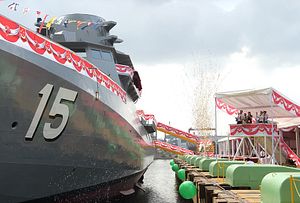On Tuesday, Singapore commissioned two more of its new locally built and designed warships. The vessels, which were unveiled at a high profile ceremony, represent another step in the country’s naval modernization, which has been in the spotlight as the Republic of Singapore Navy marks its fiftieth anniversary this year.
As I have noted before, one of the manifestations of Singapore’s naval modernization has been the replacement of its existing fleet of Fearless-class patrol vessels, which have been in service for over two decades, with locally-built and designed Littoral Mission Vessels (LMVs) that represent a marked improvement over their predecessor. The vessels are expected to be operational by 2020.
There are various ways in which the capabilities of the ship support Singapore’s defense ministry’s (MINDEF’s) characterization of it as “smarter, faster, and sharper.” (See: “What Do We Know About Singapore’s New Warship?”). The LMVs also have the versatility to deal with a wide spectrum of challenges ranging from counter-piracy to humanitarian assistance and disaster relief operations.
The LMVs have since been gradually unveiled, with the first, RSS Independence, commissioned during the RSN’s Golden Jubilee on May 5 by Singapore Prime Minister Lee Hsien Loong (See: “Singapore Unveils First New Warship Amid Navy Anniversary”). RSS Independence has already been deployed and is currently participating as part of a broader RSN Task Group in the ASEAN Multilateral Naval Exercise (See: “ASEAN’s First Naval Exercise in Perspective”).
On Tuesday, the RSN commissioned two more LMVs: RSS Sovereignty and RSS Unity. The commissioning ceremony at RSS Singapura – Changi Naval Base was officiated by Singapore’s Defense Minister Ng Eng Hen and was attended by Senior Minister of State for Defense Mohamad Maliki Bin Osman as well senior officials from MINDEF and the Singapore Armed Forces (SAF).
In his remarks at the ceremony, Ng, like other Singapore officials earlier this year, framed the progress in the LMV program in the broader context of the RSN’s evolution through its fifty years, from just three ships 50 years ago to a full-fledged Third Generation Navy with submarines, maritime patrol aircraft, and unmanned vessels and aircraft. He said that the LMVs would be useful for the RSN as demands increase to accomplish its missions, which include safeguarding sea lines of communication crucial to Singapore’s security and prosperity such as the South China Sea and the Straits of Malacca amid lingering terrorist threats and military buildups by regional actors.
Singapore is also set to assume the annually rotating ASEAN chairmanship next year, with several developments expected on the maritime security front (See: “US-Singapore Defense Ties in the Spotlight with Trump-Lee Summit”).

































